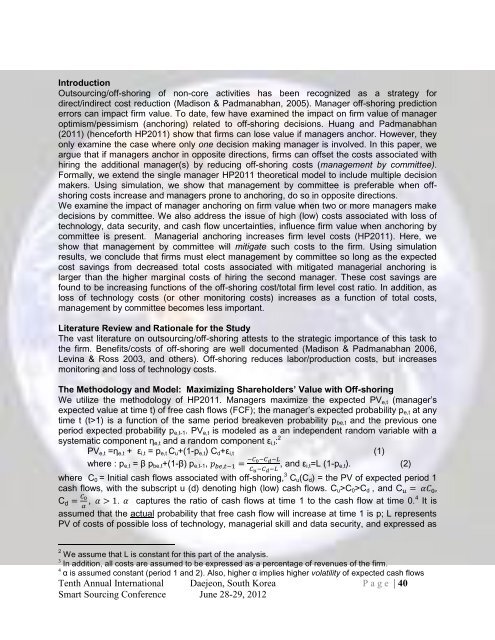of 3 - Center for Global Outsourcings
of 3 - Center for Global Outsourcings
of 3 - Center for Global Outsourcings
Create successful ePaper yourself
Turn your PDF publications into a flip-book with our unique Google optimized e-Paper software.
Introduction<br />
Outsourcing/<strong>of</strong>f-shoring <strong>of</strong> non-core activities has been recognized as a strategy <strong>for</strong><br />
direct/indirect cost reduction (Madison & Padmanabhan, 2005). Manager <strong>of</strong>f-shoring prediction<br />
errors can impact firm value. To date, few have examined the impact on firm value <strong>of</strong> manager<br />
optimism/pessimism (anchoring) related to <strong>of</strong>f-shoring decisions. Huang and Padmanabhan<br />
(2011) (hence<strong>for</strong>th HP2011) show that firms can lose value if managers anchor. However, they<br />
only examine the case where only one decision making manager is involved. In this paper, we<br />
argue that if managers anchor in opposite directions, firms can <strong>of</strong>fset the costs associated with<br />
hiring the additional manager(s) by reducing <strong>of</strong>f-shoring costs (management by committee).<br />
Formally, we extend the single manager HP2011 theoretical model to include multiple decision<br />
makers. Using simulation, we show that management by committee is preferable when <strong>of</strong>fshoring<br />
costs increase and managers prone to anchoring, do so in opposite directions.<br />
We examine the impact <strong>of</strong> manager anchoring on firm value when two or more managers make<br />
decisions by committee. We also address the issue <strong>of</strong> high (low) costs associated with loss <strong>of</strong><br />
technology, data security, and cash flow uncertainties, influence firm value when anchoring by<br />
committee is present. Managerial anchoring increases firm level costs (HP2011). Here, we<br />
show that management by committee will mitigate such costs to the firm. Using simulation<br />
results, we conclude that firms must elect management by committee so long as the expected<br />
cost savings from decreased total costs associated with mitigated managerial anchoring is<br />
larger than the higher marginal costs <strong>of</strong> hiring the second manager. These cost savings are<br />
found to be increasing functions <strong>of</strong> the <strong>of</strong>f-shoring cost/total firm level cost ratio. In addition, as<br />
loss <strong>of</strong> technology costs (or other monitoring costs) increases as a function <strong>of</strong> total costs,<br />
management by committee becomes less important.<br />
Literature Review and Rationale <strong>for</strong> the Study<br />
The vast literature on outsourcing/<strong>of</strong>f-shoring attests to the strategic importance <strong>of</strong> this task to<br />
the firm. Benefits/costs <strong>of</strong> <strong>of</strong>f-shoring are well documented (Madison & Padmanabhan 2006,<br />
Levina & Ross 2003, and others). Off-shoring reduces labor/production costs, but increases<br />
monitoring and loss <strong>of</strong> technology costs.<br />
The Methodology and Model: Maximizing Shareholders’ Value with Off-shoring<br />
We utilize the methodology <strong>of</strong> HP2011. Managers maximize the expected PVe,t (manager’s<br />
expected value at time t) <strong>of</strong> free cash flows (FCF); the manager’s expected probability pe,t at any<br />
time t (t>1) is a function <strong>of</strong> the same period breakeven probability pbe,t and the previous one<br />
period expected probability pe,t-1. PVe,t is modeled as a an independent random variable with a<br />
systematic component ηe,t and a random component εi,t: 2<br />
PVe,t =ηe,t + εi,t = pe,t Cu+(1-pe,t) Cd+εi,t (1)<br />
where : pe,t = β pbe,t+(1-β) pe,t-1,<br />
, and εi,t=L (1-pe,t). (2)<br />
where C0 = Initial cash flows associated with <strong>of</strong>f-shoring, 3 Cu(Cd) = the PV <strong>of</strong> expected period 1<br />
cash flows, with the subscript u (d) denoting high (low) cash flows. Cu>C0>Cd , and C<br />
Cd . captures the ratio <strong>of</strong> cash flows at time 1 to the cash flow at time 0. 4 It is<br />
assumed that the actual probability that free cash flow will increase at time 1 is p; L represents<br />
PV <strong>of</strong> costs <strong>of</strong> possible loss <strong>of</strong> technology, managerial skill and data security, and expressed as<br />
2 We assume that L is constant <strong>for</strong> this part <strong>of</strong> the analysis.<br />
3 In addition, all costs are assumed to be expressed as a percentage <strong>of</strong> revenues <strong>of</strong> the firm.<br />
4 α is assumed constant (period 1 and 2). Also, higher α implies higher volatility <strong>of</strong> expected cash flows<br />
Tenth Annual International Daejeon, South Korea P a g e | 40<br />
Smart Sourcing Conference June 28-29, 2012



